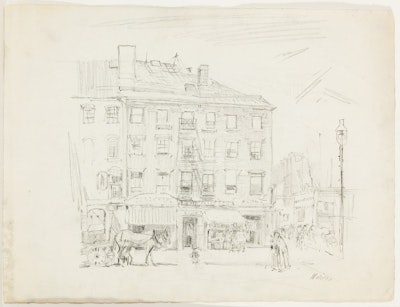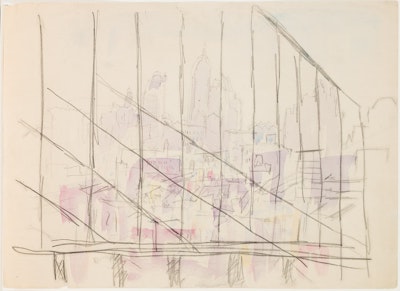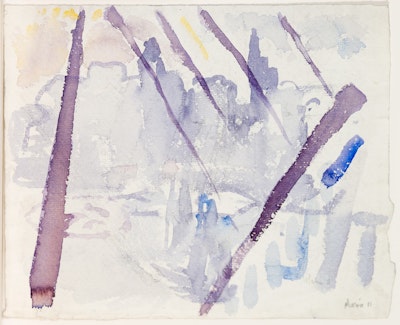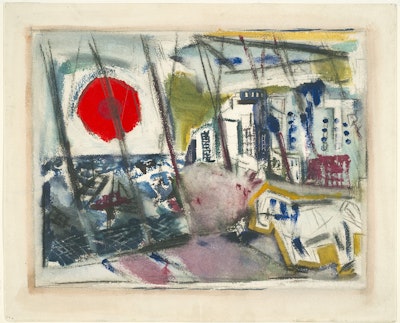Brooklyn Bridge
The iconic suspension bridge was constructed between 1869 and 1883. This meant that the project, which demanded much money and labor and cost many lives, was prominent in the news starting before Marin’s birth and continuing through much of his childhood. The bridge was always part of his life. At an early stage when Marin had started the transition from architect to fine art, he made a drawing of the New York waterfront at Peck Slip and South Street, with one of the bridge’s massive stone towers appearing. At this early point in his career, Marin worked in a style formed by the popular illustrations of the period.
Drawing is the path of all movement Great and Small —
John Marin, unpublished notes
Drawing is the path made visible.
When Marin returned from Europe in 1909 as a newly minted modern artist, he found the familiar Brooklyn Bridge standing in the company of new skyscrapers that came to symbolize the modern city. The elevated boardwalk of the Brooklyn Bridge became one of Marin’s favorite vantage points for showing the rapidly evolving Manhattan skyline in sketches, watercolors, and etchings.
In this watercolor made from the boardwalk of the Brooklyn Bridge, looking through the network of suspension cables, the tallest tower is the Singer Building. This building, now largely forgotten, was once a major presence on the Manhattan skyline. The Singer Building opened on Broadway in 1908 and was demolished in 1968.
A more abstracted version of the same view stresses the powerful forces at work in the steel cables keeping the bridge aloft despite the weights, pressures, and winds it faces.
In later years, Marin continued to search for new ways to represent the dynamic power of the bridge and the way it interacted with the buildings around it and the people on it. He made numerous rough sketches that appear to have been made on the spot as he walked back and forth across the bridge.
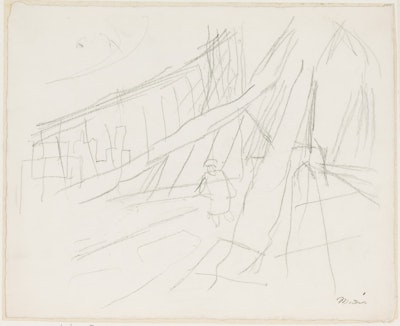
On the Brooklyn Bridge(Circa 1920)
John Marin, On the Brooklyn Bridge, circa 1920, graphite on paper drymounted to board, 6 ⅞ × 8 ½ in. (17.46 × 21.59 cm.), Arkansas Arts Center Foundation Collection: Gift of Norma B. Marin, New York, New York. 2013.018.116
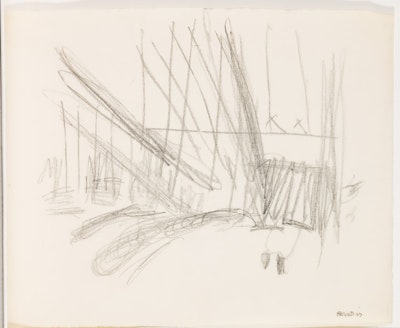
On the Brooklyn Bridge(Circa 1920)
John Marin, On the Brooklyn Bridge, circa 1920, graphite on paper, 6 ⅞ × 8 ½ in. (17.46 × 21.59 cm.), Arkansas Arts Center Foundation Collection: Gift of Norma B. Marin, New York, New York. 2013.018.117
Draw it carefully in your mind Then write it down quickly.
John Marin, unpublished notes
Marin’s modernist productions during his early years back in New York showed his continuing fascination with the great bridge and the active city around it. He often caught dramatic natural light at work in sunrises and sunsets.
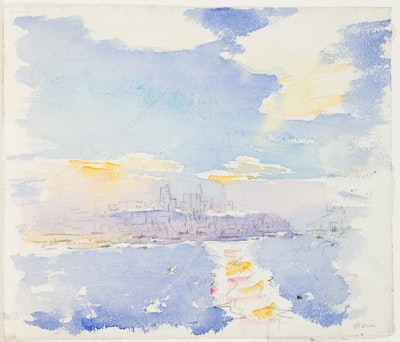
Manhattan Skyline from the River
John Marin, Manhattan Skyline from the River, 1909–1912, watercolor over graphite on textured watercolor paper, 11 ½ × 12 ¾ in. (29.21 × 32.38 cm.), Arkansas Arts Center Foundation Collection, Gift of Norma B. Marin, New York, New York. 2013.018.152
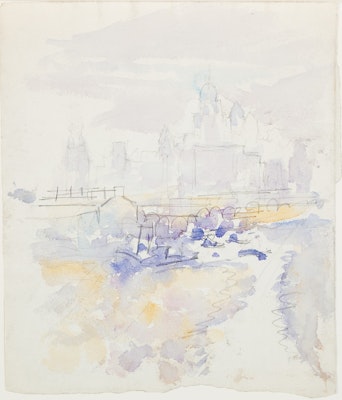
River Movement, Manhattan Skyline
John Marin, River Movement, Manhattan Skyline, 1910-1912, graphite and watercolor on textured watercolor paper, 12 ¾ × 10 ¾ in. (32.38 × 27.30 cm.), Arkansas Arts Center Foundation Collection, Gift of Norma B. Marin, New York, New York. 2013.018.154
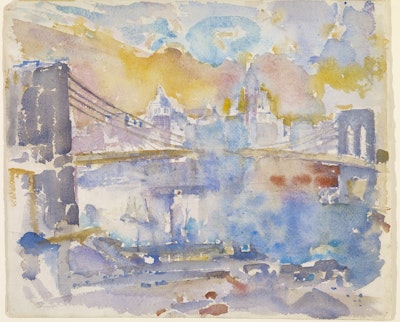
Brooklyn Bridge
John Marin, Brooklyn Bridge, 1912, watercolor and graphite on paper, 15 ½ × 18 ½ inches (39.37 × 46.99 cm.), Colby College Museum of Art, Gift of John Marin Jr. and Norma B. Marin, 1973.042, SR.12.12
The etchings that Marin made of the Brooklyn Bridge in 1913 were among his most innovative modern images of New York. The “great movement” and “forces at work” in the city that Marin described in his 1913 commentary are brought to life in the heaving forms and dynamic line work of Brooklyn Bridge No.6 (Swaying).
Also see the Woolworth Building story for more about New York City.
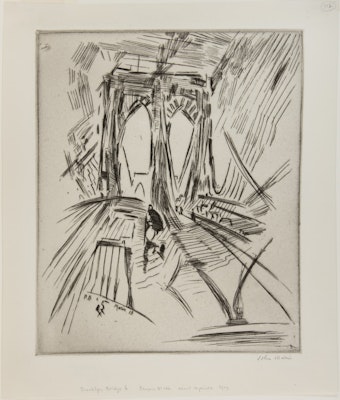
Brooklyn Bridge, No. 6 (Swaying) Six, New York Etchings
John Marin, Brooklyn Bridge, No. 6 (Swaying) Six, New York Etchings, 1913, etching, plate: 10 ¾ × 8 ⅞ inches (27.3 × 22.5 cm.), sheet: 13 1/16 × 11 ⅛ inches (33.2 × 28.3 cm.), Philadelphia Museum of Art, Purchased with the Lola Downin Peck Fund from the Carl and Laura Zigrosser Collection, 1967, 1967-31-99, CZ.112, Copyright: © Estate of John Marin / Artists Rights Society (ARS), New York
Do you want to know what I think about etchings and what they should be? Well, little letters of places.
John Marin, quoted by E. A. Taylor in “The American Colony of Artists in Paris.” Studio 53 (July 1911): 112–15
In the 1940s, Marin again made etchings of the Bridge. As he prepared to make the etchings, he created several sketches of a horse pulling a wagon across the bridge.
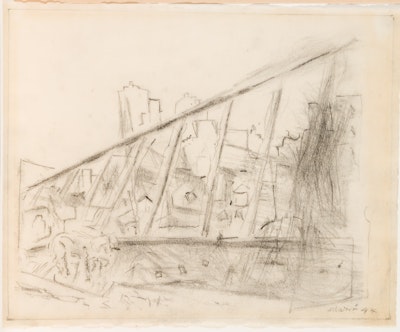
Brooklyn Bridge — On the Bridge
John Marin, Brooklyn Bridge — On the Bridge, 1944, graphite on tracing paper, 6 ⅝ × 8 ⅛ in. (16.83 × 20.64 cm.), Arkansas Arts Center Foundation Collection: Gift of Norma B. Marin, New York, New York. 2013.018.210
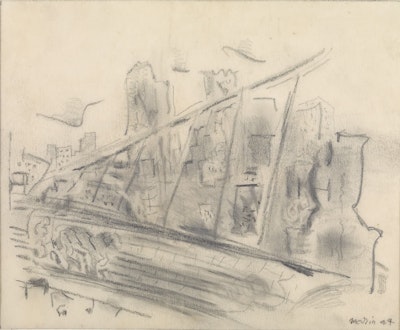
Brooklyn Bridge, On the Bridge
John Marin, Brooklyn Bridge, On the Bridge, 1944, graphite and charcoal on paper, 6 ¼ × 7 ⅞ inches (15.88 × 20 cm.), Colby College Museum of Art, 1973.053
The sketches are mirror images of the etchings, because the printing process reverses the image etched on the copper plates from which the images on paper are printed.
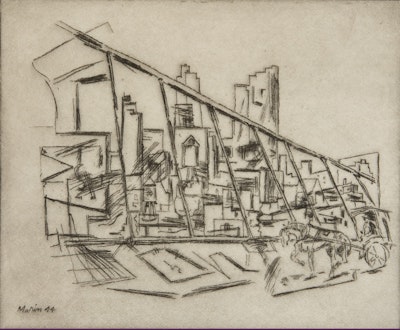
Brooklyn Bridge — On the Bridge(No. 1, Sheet)
John Marin, Brooklyn Bridge — On the Bridge, No. 1, 1944, etching, plate: 6 5/16 × 7 ⅝ in. (16.1 × 19.4 cm.), sheet: 7 ⅝ × 10 5/16 in. (19.3 × 26.2 cm.), Philadelphia Museum of Art, The J. Wolfe Golden and Celeste Golden Collection of Marin Etchings, 1969, 1969-81-125, CZ.163, Copyright: © Estate of John Marin / Artists Rights Society (ARS), New York
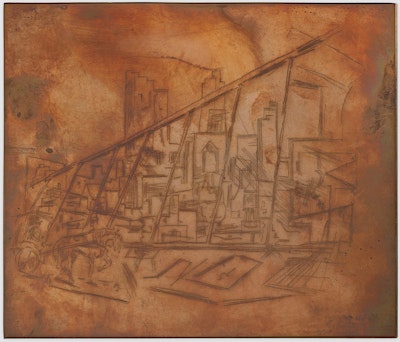
Brooklyn Bridge — On the Bridge( No. 1, Plate)
John Marin, Brooklyn Bridge — On the Bridge, No. 1, 1944, copper etching plate: 6 ⅜ × 7 ¾ inches (16.2 × 19.7 cm), Philadelphia Museum of Art, Gift of Norma Marin, 1997, 1997-189-50, Copyright: © Estate of John Marin / Artists Rights Society (ARS), New York
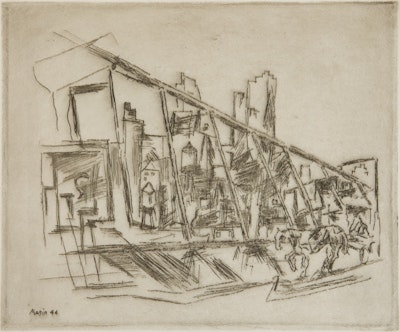
Brooklyn Bridge — On the Bridge(No. 2, Sheet)
John Marin, Brooklyn Bridge — On the Bridge, No. 2, (second state), 1944, etching, plate: 6 5/16 × 7 ⅞ in. (16.1 × 20 cm.), sheet 7 ⅛ × 9 1/16 in. (18.1 × 23 cm.), Philadelphia Museum of Art, The J. Wolfe Golden and Celeste Golden Collection of Marin Etchings, 1969, 1969-81-127, CZ.164ii, Copyright: © Estate of John Marin / Artists Rights Society (ARS), New York
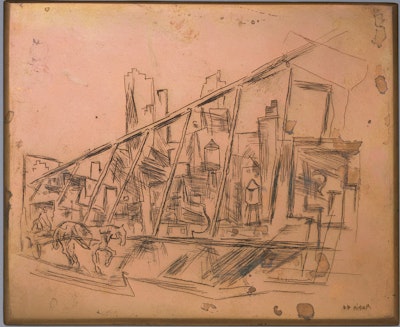
Brooklyn Bridge — On the Bridge(No. 2, Plate)
John Marin, Brooklyn Bridge — On the Bridge, No. 2, 1944, copper etching plate, plate: 6 7/16 × 7 ⅞ inches (16.4 × 20 cm.), Philadelphia Museum of Art, Gift of Norma Marin, 1997, 1997-189-51, Copyright: © Estate of John Marin / Artists Rights Society (ARS), New York
